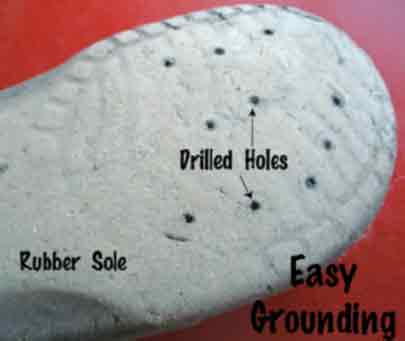
For dry places, easily ground your shoes by drilling small holes in the sole. The foot perspires and the resulting moisture provides a grounding path, to the ground you walk on. Natural moisture from foot perspiration, provides a slight bit of electrical conductivity. Conductivity is natural with breathing shoe wear. Adding vents in the sole is an added solution for a rural or any unpolluted landscape.

I reason that the amount of conductivity is likely greater than the dry land which is walked on. Inserted copper or metal conductors, as some manufacturers now do, is over doing it, in terms of electrical conductivity. Furthermore, as a shoe wears, a piece of metal will be noticeable and feel uneven or bothersome.
I have been testing this for months in a wet area (2013 Maine, USA). I was surprised how little water penetrates my sole. Water generally does not penetrate the small drilled holes, on humid lawn grass. Only the immersion in puddles, or stepping on soggy surfaces let water penetrate. Otherwise, the added ventilation at the sole, is an additional benefit. A little water seeps in if walking on very wet snow (if it is holding fresh rain water). Dry snow, not melting snow), stays out of drilled hole in my experience. I like the drilled soles for indoor life of the winters, as homes are arid, dry, due to heating.
Before synthetics, plastic or rubber were used in shoes, the rawer forms of natural materials tend to breath more, imparting more electrical conductivity, in shoes. Poorer people tend to wear footwear longer an open up little cracks or air passages equal to dilled holes. The conductivity is more of a static electricity, at nearly imperceptible levels. Yet there is a huge collective agreement growing to support this phenomena. The drilled hole method allows any existing shoe to be modified, to ensure this conceptual benefit. I first tested this with my work shoes and increasingly dilled more of my footwear. To ease drilling, a scrap piece of wood could temporarily be put in the shoe, to avoid drilling through the top of shoe accidentally.
Stuffing absorbent twine or cloth material into the holes for better foot dryness, on very wet ground, also adjusts functionality. Small puddle penetration might thus be sufficiently blocked. Dry ground has very little electrical conductivity, so this ground-surface conductivity might as well be optimized with partially moisture retentive plugs.
Ordinary ohm meters generally cannot read that high a level of electrical resistance. But megohm meters can reach that level of testing